How Form-Based Code (FBC) Reduces Sprawl & Builds Communities
When examining the origins of Form-Based Code (FBC) through a Google search, it highlights the work of Andres Duany and Elizabeth Plater-Zyberk, who created the first modern form-based code during the development of Seaside, Florida in 1982. However, the true genesis of any new idea often involves preliminary research, conceptualization, dialogues, and the identification of opportunities that precede its official recognition. Personally, my journey into this topic began during my time at Rice University in the late 1970s, where I had the privilege of attending a lecture by Robert Davis in 1979. Davis, a developer, had inherited 80 acres of seemingly barren land along the coast of the Florida panhandle (Figure 3). After a comprehensive study of various southern cities, towns, and neighborhoods, he presented his findings to the Houston design community, accompanied by slides of precedent studies and site plans, revealing his plans to hire an architectural firm.
This firm happened to be the brainchild of Andres Duany and Elizabeth Plater-Zyberk. Once hired by Robert Davis, the duo embarked on their own expedition to study existing southern communities, meticulously documenting each location with photographs, measurements, and notes to grasp the essence of each context. Subsequently, in 1980, Andres presented the Seaside master plan and the initial principles that would later be integrated into the first modern form-based code during his lecture at Rice. Many of these principles sought to revive the essence of traditional town planning that had been overshadowed by the rise of automobiles, conventional zoning that separated various uses and users, consequently leading to sprawling developments. It harkened back to the image of the traditional Main Streets and Town Squares of middle America, characterized by compact mixed-use commercial buildings aligned closely with the front property lines, defining vibrant “Urban Places.” Moreover, it invoked the idea of residential spaces situated above these ground-floor commercial establishments.
To answer the question “What is a Form-Based Code” it might be helpful to cite the definition in the recently adopted “City of Las Vegas Form-Based Code.” It reads: “A Form-Based Code (FBC) is a place-based planning approach that supports walkable, mixed-use, and compact urban environments rather than suburban development and sprawl. A FBC is an alternate to a conventional zoning code.”
The framework or organizing principle for the Form-Based Code is a hierarchy of environments or places based on character. The Rural-to-Urban Transect is this framework & the designation of each zone along this hierarchy is first determined by character, form, intensity of development, & type of environment, & secondly, by the uses allowed. The typical number of Transects (referred to as “T-zones”) for US Towns is 6 plus an additional Special District. The 6 are as follows: Natural (T1), Rural (T2), Sub-Urban (T3), General Urban (T4), Urban Center (T5), & Urban Core (T6). The additional Special District (SD) is places with specialized purposes, like heavy industrial, university, etc.
By foregoing conventional zoning and utilizing the FBC framework above, along with other related considerations, planners have begun to make a dent in all the ills associated with the way we have built communities since World War II. Many publications document the affects that single-use zoning, massive road construction, and urban disinvestment have had on our neighborhoods. These include environmental, social, poverty, lack of diversity, lack of opportunity, and physiological. This post World War II pattern of developing our nation, has taken what was a nation of ecologically and economically sustainable communities, and turned into a nation of far-flung suburban sprawl.
The ongoing revitalization of certain neighborhoods, stands as a testament to the transformative power of foregoing conventional zoning and embracing the principles of the FBC framework, thereby addressing the various societal challenges stemming from the post-World War II development landscape. On a recent trip to visit my family, I stayed with my son, my daughter-in-law, and two grandchildren. They live within the city limits of Kansas City, and between their house and the downtown core, there are a number of Districts, that are being revitalized into vibrant neighborhoods. In my son’s neighborhood you can walk to the store, the bank, the park, and even spend an afternoon at “Rainy Day Books’; all without ever getting in your car. This is a neighborhood that Mr. Rogers would be happy to call home.
 Robert “Bob” Olson is a Project Manager at LGA and combines nearly 40 years of architectural & planning experience, over 15 years of real estate valuation experience, and nearly 10 years as an Adjunct Instructor within Iowa State University’s Department of Architecture. Bob is both a Registered Architect and a Practicing Affiliate Member of the Appraisal Institute in the state of Nevada. As an architect, Bob has been involved in almost all building types of all sizes, functioning as a Project Architect, Project Manager, and Project Designer. He’s successfully completed projects in Iowa and a half dozen other states as well as in Mexico and the Middle East. Bob’s design work was recognized with eight AIA Design Awards, both at Regional and State AIA levels. He moved to Las Vegas in July of 2019 and looks forward to getting involved with worthwhile causes in the Las Vegas area.
Robert “Bob” Olson is a Project Manager at LGA and combines nearly 40 years of architectural & planning experience, over 15 years of real estate valuation experience, and nearly 10 years as an Adjunct Instructor within Iowa State University’s Department of Architecture. Bob is both a Registered Architect and a Practicing Affiliate Member of the Appraisal Institute in the state of Nevada. As an architect, Bob has been involved in almost all building types of all sizes, functioning as a Project Architect, Project Manager, and Project Designer. He’s successfully completed projects in Iowa and a half dozen other states as well as in Mexico and the Middle East. Bob’s design work was recognized with eight AIA Design Awards, both at Regional and State AIA levels. He moved to Las Vegas in July of 2019 and looks forward to getting involved with worthwhile causes in the Las Vegas area.
